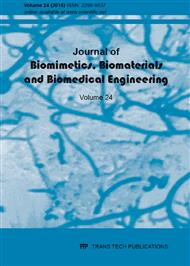[1]
Robbins JW, Guidelines for the restoration of endodontically treated teeth, J Am Dent Assoc. 120 (1990) 558-566.
Google Scholar
[2]
Goodacre CJ and Spolnik K J, The prosthodontic management of endodontically treated teeth, J Prosthodont. 2 (1994) 243-250.
Google Scholar
[3]
T. Hirano and T. Yamada, Multi-paradigm expert system architecture based upon the inverse design concept, in Proceedings of the International Workshop on Artificial Intelligence for Industrial Applications, Hitachi, Japan, (1988) p.25–27.
DOI: 10.1109/aiia.1988.13301
Google Scholar
[4]
M. Niino and S. Maeda, Recent development status of functionally gradient materials, ISIJ International. 30(9) (1990) 699-703.
DOI: 10.2355/isijinternational.30.699
Google Scholar
[5]
M. Yamanoushi, M. Koizumi, T. Hiraii, and I. Shiota, Eds., Proceedings of the 1st International Symposium on Functionally Gradient Materials, Sendai, Japan, (1990).
Google Scholar
[6]
M. Koizumi, The concept of FGM. Ceramic transactions, Functionally Gradient Materials. 34 (1993) 3-10.
Google Scholar
[7]
Chung, Y.L., and Chi, S.H., 2001, The residual stress of functionally graded materials, Journal of the Chinese Institute of Civil and Hydraulic Engineering. 13(2001)1-9.
Google Scholar
[8]
Chi, S.H., and Chung, Y.L., Cracking in sigmoid functionally graded coating, Journal of Mechanics, 18 (2002) 41-53.
Google Scholar
[9]
Wasim M.K. Helal, and D.Y. Shi, Indian Journal of Materials Science. 2014 (2014)7 P.
Google Scholar
[10]
Standlee JP, Caputo AA, and Hanson EC, Retention of endodontic dowels: effects of cement, dowel length, diameter, and design, J Prosthet Dent. 39 (1978) 401-405.
DOI: 10.1016/s0022-3913(78)80156-5
Google Scholar
[11]
Felton DA, Webb EL, Kanoy BE, and Dugoni J, Threaded endodontic dowels: effect of post design on incidence of root fracture, J Prosthet Dent. 65 (1991) 179-87.
DOI: 10.1016/0022-3913(91)90159-t
Google Scholar
[12]
Johnson JK, and Sakamura JS, Dowel form and tensile force, J Prosthet Dent. 40 (1978) 645-649.
Google Scholar
[13]
Wasim M.K. Helal, and Dongyan, Shi, Analysis of functionally graded rectangular plate by ANSYS, Key Engineering Materials. 572 (2014) 505-508.
DOI: 10.4028/www.scientific.net/kem.572.505
Google Scholar
[14]
ANSYS User's Manual, Version 12. 1.
Google Scholar
[15]
M. Yamanoushi and M. Koizumi, Functionally gradient materials, in Proceedings of the 1st International Symposium on Functionally Graded Materials, Sendai, Japan, (1991).
Google Scholar
[16]
Y. Fukui, Fundamental investigation of functionally gradient material manufacturing system using centrifugal force, JSME International Journal. 34 (1) (1991) 144-148.
DOI: 10.1299/jsmec1988.34.144
Google Scholar
[17]
F. Delale and F. Erdogan, The crack problem for a nonhomogeneous plane, ASME Journal of Applied Mechanics. 50 (3), (1983) 609-614.
DOI: 10.1115/1.3167098
Google Scholar
[18]
Joshi S, Mukherjee A, Kheur M, and Mehta A, Mechanical performance of endodontically treated teeth. Finite Elem Anal Des, Dent Mater J. 37 ( 2001) 587-601.
DOI: 10.1016/s0168-874x(00)00059-7
Google Scholar
[19]
Genovese K, Lamberti L, and Pappalettere C, Finite element analysis of a new customized composite post system for endodontically treated teeth, J Biomech. 38 (2005) 2375-2389.
DOI: 10.1016/j.jbiomech.2004.10.009
Google Scholar
[20]
T. Fuchiyama, N. Noda, T. Tsuji, and Y. Obata, Analysis of thermal stress and stress intensity factor of functionally gradient materials, in Ceramic Transactions: Functionally Gradient Materials, I. B. Holt, Ed., American Ceramic Society, Westerville, Ohio, USA. 34 (1993).
Google Scholar
[21]
T. Fuchiyama and N. Noda, Multiple crack growths in the functionally graded plate under thermal shock, in Proceedings of the 4th International Congress on Thermal Stresses, Osaka, Japan, (2001) 121-124.
DOI: 10.1080/014957301750379621
Google Scholar


